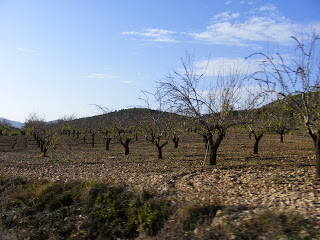The Costa Blanca gets a rough ride sometimes; notorious Benidorm with it's skyscrapers, pubs and English breakfasts is probably the most well known area. Then theres the over-development, hideous economic situation and widepsread corruption; which doesn't help.

(Benidorm - image courtesy of gestaltur.com)
Few people realise that the mountainous areas around Benidorm are considered among the most adventurous areas in Spain to explore!
The Costa Blanca has a lot on offer, especially with regard to adventure sports, it's just some tourist offices don't do the best job at promoting it and the local authorities don't nurture small business, so it's a tough environment to break in to.
Beautiful terrain is awaiting; hiking - 'senderismo' - is huge in Spain. Move off the well beaten track and there is a lot on offer; mountains, beaches, woodland, scrub, saltlakes and rivers.

Nordic walking is proving popular and the Spanish Nordic Walking Association is growing at a very healthy rate. Check them out for information about walks and the development of the sport in the Valencian area:
http://
nordicwalking-ane.es/
Here are a couple of good suggestions where to start if you want to explore:
The Aitana Sierra and el Puig Campana: Inbetween La Marina and l'Alcoià-Comtat in the Costa Blanca north there is an imposing limestone mountain range which streches out over two thousand hectares. At 1,558 metres above sea level, the Aitana Sierra is dominated by sheer cliffs, gigantic boulders and massive fissures; some over eighty metres deep!

(Sierra de Aitana)
Nearby, el Puig Campana stands at 1,410 metres above sea level. Its cliff faces, pinnacles and peaks carved in limestone give the surrounding landscape an impressive, rugged look. These areas are great for enthusiasts with good fitness levels who like to exert themselves. Cycling is another way to enjoy the sights, even if you do get a lift to the top and arrange for the car to meet you at the bottom!

(el Puig Campana - image courtesy of panoramio.com)
This area is also popular with both national and international climbers. The Ponoig (1,181m) near Polop, Puig Campana (1,410m) near Finestrat, and the Penyal Diví near Sella are all exciting challenges.

Quaint mountain villages nestled in valleys, ancient Moorish ruins, wayside chapels and lush farmland are spread across the area. To the east the sea lies at the bottom of a steep slope, on a clear day the party island of Ibiza can be seen. Keep an eye out and you may see Peregrine Falcon, Golden Eagle and Bonelli's Eagle.
Benifato, Confrides and Sella are all set beautifully in the range, and are great places to rest and take lunch. Nearby, Guadalest sits above a turquoise-coloured lake and although still beautiful, can be a bit of a tourist trap in the summer.

(Guadalest)
La Mata and Torrevieja Lagoons Nature Park:These areas are made up of lagoons which spread across Torrevieja, Los Montesinos, Guardamar del Segura and La Mata in the Costa Blanca south. For decades these lagoons have been used for salt extraction and the marshlands joining the lagoons are an important wintering and nesting area for over numerous bird species, most notably the Greater Flamingo and Black-Necked Grebe.
As these areas comprise of large, flat expanses, people of any fitness level will find it easy to park up and go for a gentle stroll. The area is popular with photographers due to the scenery and opportunities to picture flamingo's and locally rare birds.

(Torrevieja salt lagoons - image courtesy of stitchesoftime.wordpress.com)
For more information about this specific area, contact the Nature Park Information Centre on: 966 920 404.
There are 22 'Nature Parks' in the region of Valencia, offering sensual contrasts to visitors and adventure sports enthusiasts. In the north the Iberian mountain range provides many challenging environments, in the central part of the region, there are hills and plains, and to the south the land turns mountainous once again, to the Baetic Cordillera sierras.
If you want to do some serious walking then factors to consider include the time of year (don't bother in the summer - it's way too hot!), area, grading systems and being properly organised - don't forget valid travel / health insurance, maps and water!!
This post is a very, very small insight in to what is a hugely varied and popular activity throughout the Costa Blanca, Valencia and Spain as a whole. Postings about walking, hiking and mountainous activities will be a regular fixture on this Blog.
RESOURCES:The amount of information circulating about walking in the Costa Blanca and Valencian region is increasing, so it has never been easier to up sticks and explore. A great book for people who want to hike in the area is 'Hiking in Spain', written by Stuart Butler and published by the Lonely Planet:
http://
www.amazon.co.uk/Hiking-Spain-Lonely-Planet-Walking/dp/1741044707/ref=sr_1_1?ie=UTF8&qid=1291126870&sr=8-1The best place for walking information is the Centro Excusionista de Valencia (Spanish only): http://
www.centroexcursionista.org/ Although the Valencian Community website is also good: http://
en.comunitatvalenciana.com/organiza-tu-viaje-mapas-guias-y-planos-guias-de-rutas-y-excursiones/2?k=3&user=logged and has lots of guides that can be downloaded for free.
For everything you need to know about walking in Spain, check out the national walking organisation; FEDME: http://
www.fedme.es/The best overall map of the area is Michelin's No.577 Comunidad Valenciana & Murcia (1:400,000). Maps can be bought at http://
www.libreriapatagonia.com/












































